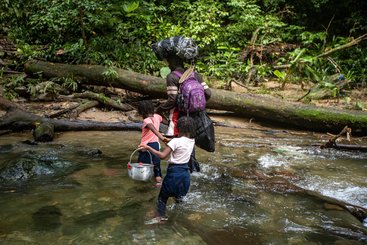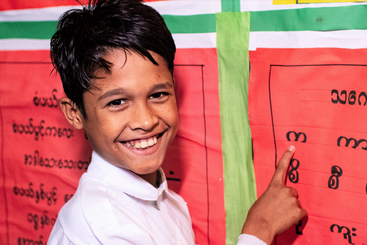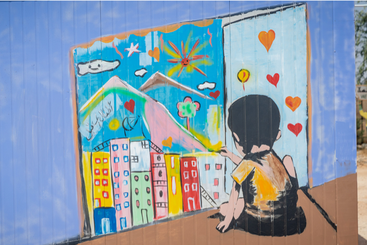International Migrants Day is an opportunity to highlight the challenges faced by migrants, as well as their contributions to the societies and communities they move to. Here, we celebrate the Latin American region, reflecting on the good practices and innovations that have promoted the inclusion of children with irregular migration status.
Inclusion is important in the region, with migrant contributions forecast to increase GDP by as much as 4.5 percentage points by 2030, and with key contributions to other areas, including the health and care sector. More than anything, as many children start a new life in their host countries, it is important to reflect on what works to promote their sustained inclusion.
More children are undertaking longer and more dangerous journeys to settle in the region
Children are migrating through Latin America and the Caribbean in record numbers. In the first six months of 2023, UNICEF estimates that more than 40,000 children crossed the Darien jungle, making it the year with the most child crossings on record. Younger children are making these perilous journeys, with those under 11 years now accounting for up to 91% of all children on the move at some key transit points. Children are faced with several dangers that come when crossing countries and at times the entire region – via jungles, rivers, railway lines, highways – such as injury, family separation, exploitation, gang violence or health risks. The dangers (including loss of lives) increase when ‘coyotes’ (traffickers) offer ‘VIP routes’, such as travelling via fishing boats from the Colombian island of San Andres to Nicaragua, or ‘safe passages’ such as crossings from Guatemala to Mexico across the Usumacinta River.
The numbers of displaced children and their families settling in host societies are also increasing. For instance, R4V estimates that 6.5 million migrants and refugees have left Venezuela, with most of them living in other countries of Latin America and the Caribbean, mainly Colombia, Peru, Brazil, Ecuador, and Chile. Similarly, UNICEF has estimated that in 2020 there were 870,000 migrants and refugees from Haiti in other countries in the region, particularly in the Dominican Republic, Chile and Brazil.
Here, we highlight some of the initiatives and good practices in the region identified in our ‘children on the move’ evidence review. We reflect on the evidence gaps and provide suggestions on what governments and other practitioners can do to further support the inclusion of children, regardless of their migration status.
Good practices in children’s inclusion from the region
The following flagship policies and programming have contributed to efforts to integrate children in Latin America and the Caribbean in different areas. Although the effectiveness of some of these initiatives is unclear – and we stress the need for evaluation of impact – they provide good examples of promising initiatives to integrate children in host countries.
- Inclusion in education
Documentation barriers in refugee-hosting contexts have been reduced thanks to the Andrés Bello Convention, whose signatories have agreed to recognise students’ prior qualifications and school certificates. ODI research in Ecuador found that the Convention has been an important policy framework that facilitates refugee students’ transfer into Ecuador’s education system.
Increasing school capacity is also critical. In June 2019, Peru’s education ministry launched Lima Aprende (Lima Learns), an initiative to ensure all children in the capital, including displaced children, are in school. The programme expanded the availability of school places by making enrolment requirements more flexible, creating 10,880 spaces and 401 primary school classrooms.
- Music, arts and social cohesion
Activities that promote music and the arts have strengthened social cohesion between displaced children and their hosts. For instance, the enrolment of refugee children into local music schools, launched by the United Nations Refugee Agency (UNHCR) and the Simon Bolivar MUSIC Foundation (FUNDAMUSICAL) in Venezuela, promoted an increased sense of belonging among displaced children and their families in their communities. Other promising examples in the region, although not yet evaluated, are a mobile school of arts and ‘batucadas’ (street bands) in Colombia, bi-national choirs in Ecuador and multi-national orchestras with displaced children in Chile, taught by Venezuelan teachers.
- Alternative care models
Alternative care models – although many are small scale – are providing alternatives to immigration detention for unaccompanied displaced children. For instance, Mexico has developed a foster care programme to support the long-term inclusion of unaccompanied children, by connecting them with a social network of appropriately trained families. Initiated in five federal regions, 152 migrant and refugee children were fostered between November 2020 and December 2021, as identified in our evidence review. The programme continues to expand, with similar initiatives taking place in Colombia and Peru through the Aldeas Infantiles SOS group homes.
- Independent living and transition to work
In Ecuador, through UNICEF and the Danielle Children’s Fund, unaccompanied adolescents have received financial support to cover the cost of rent for six months, training in various trades and entrepreneurship to increase employment opportunities. Similar initiatives have been implemented in Mexico with displaced children, and in Brazil with indigenous youth displaced from Venezuela.
Evaluation of impact is needed to improve and expand promising initiatives
Despite their promise, very few of these initiatives have been evaluated, or lessons from their implementation systematised. This means that the effectiveness of different initiatives and their impacts on migrant children, families and host communities are not well understood. In their absence, assumptions on good practices take the place of evidence. This means that a wealth of experience and innovation is not being captured and shared, both within the region and beyond.
Given that the rise in xenophobia and racism in the region, as in other parts of the world, is often directed at migrant children and their families, it is particularly important to understand and share lessons on good practices that support both settled migrant and host communities. A vital element to prevent or reduce xenophobia is to address the lack of opportunities and services affecting both displaced people and host communities.
Given the scale of human mobility in the region, it is understandable that evaluation and data collection is often a low priority, compared, for instance, to service delivery for affected children and host communities.
As such, the increased pooling of funds for relevant and timely evidence and evaluation is urgently needed. Other ways to generate a clearer understanding of what is working – and what is not – include making greater use of publicly available data to understand the impacts of policy changes on children on the move (e.g. with respect to regularisation or entitlements to particular services). Data sources could include civil registries, administrative data from public services, and household surveys.
Finally, it is crucial to better understand the preferences and perspectives of children and families on how to meaningfully facilitate their inclusion in host societies. Action research – involving children, young people and families from migrant and host communities – that simultaneously supports change initiatives can help to ensure that efforts to strengthen the knowledge base lead to positive change in children’s lives.
ODI’s pledge at the Global Refugee Forum
Last week at the Global Refugee Forum, as part of the multi-stakeholder pledges on Child Rights and Economic Inclusion and Social Protection, ODI committed to building the evidence base on the effective inclusion of children and youths on the move in Latin America, the Caribbean and beyond.
Over the next four years, we hope to learn from promising initiatives on children’s inclusion to date, and support more inclusive, impactful approaches moving forward. To do so, we will build evidence on the economic inclusion of displaced children transitioning into adulthood, their mental health and psychological wellbeing, sexual and reproductive health, and educational inclusion. Critically, we will take an intersectional perspective to understand specific challenges faced by those often marginalised on the basis of their gender, sexual orientation, race, ethnicity and/or other characteristics.
This expanded research focus will build on ODI’s work to date on Children and families on the move in Latin America and the Caribbean, on What works to protect Children on the Move, and insights from the Gender and Adolescence Global Evidence (GAGE) programme.




